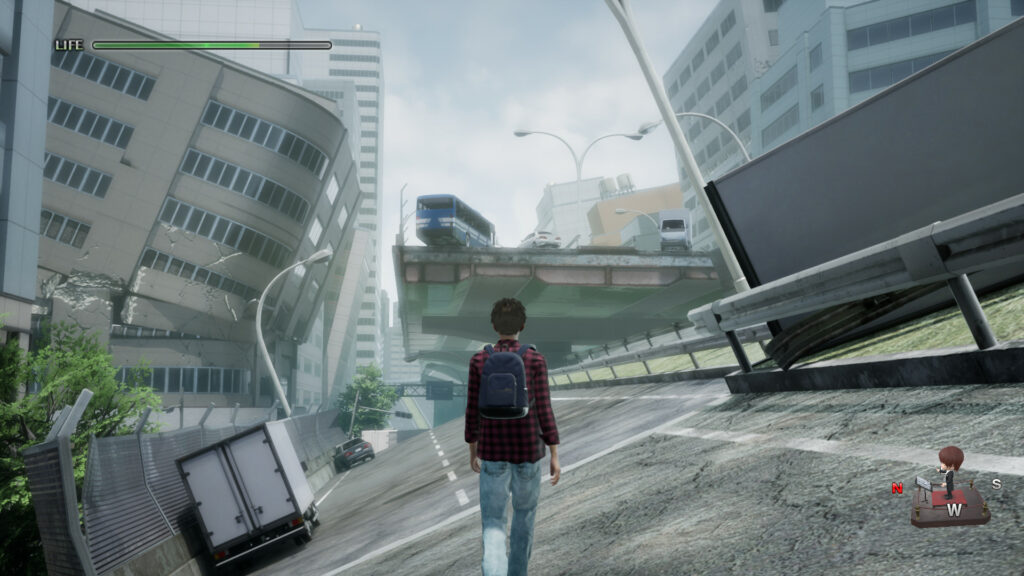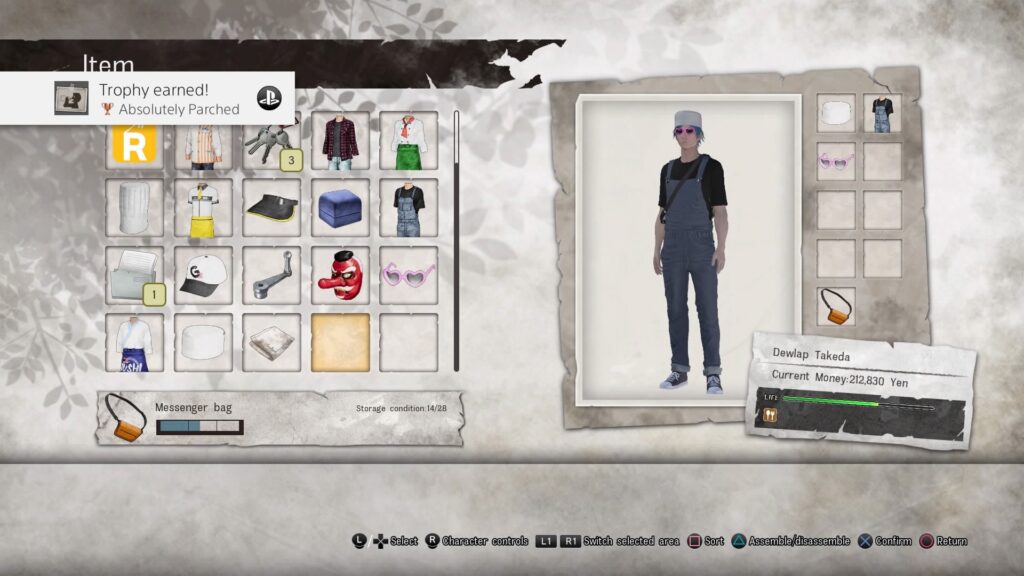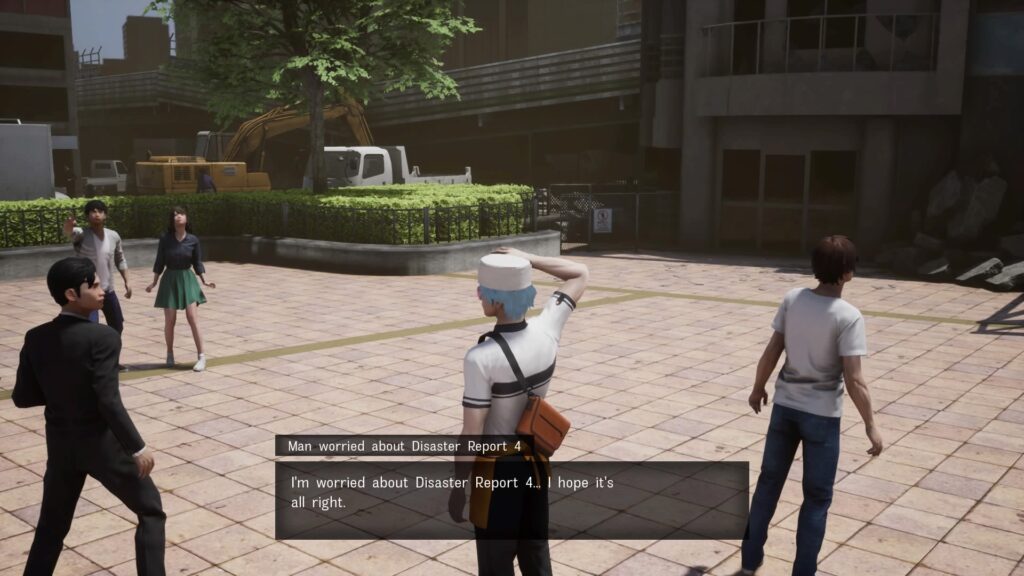
Apocalypse Now but make it serene
Mild spoilers of the weirdness contained within Disaster Report 4 are present in this article, if you’re already sold on the franchise or weird games in general, give it a shot in advance of reading this. There’s a demo available on all digital storefronts.
On April 7th, 2020, a few weeks deep into a crisis whose impact is global and total ramifications unknown, Granzella’s Disaster Report 4: Summer Memories snuck its way onto digital storefronts. What may come off as dubious timing is more a case of dubiously bad luck. The game was outright canceled nine years prior due to the 2011 Tōhoku earthquake and tsunami, and its revived release date set in stone prior to any murmurings of COVID-19. The conspicuously low budget franchise was always a bit out of time with its contemporaries and now stands as possibly the homeliest title on PSN that isn’t developed by 1Games.
At the intersection of Deadly Premonition’s idiosyncrasies and Death Stranding’s languid pace, Disaster Report 4: Summer Memories can only be appreciated on the merits of it being like absolutely nothing else. It’s more difficult to do so than with franchise masterwork Raw Danger, whose shifting gameplay amongst different protagonists and converging narratives stands tall over any other natural disaster navigation game. Summer Memories is a visible downgrade from Raw Danger in every capacity but graphical fidelity, yet the franchise’s unparalleled tone still rings through, compelling me to blaze through what should amount to diminishing returns in the span of a week.
Even compared to its set piece-inhibited predecessors, the disaster in Disaster Report 4 is mostly kept to the background. You primarily lurk the aftermaths of a lingering earthquake tearing environments apart and taking the communities with it. Besides a perfunctory landscape shake mechanic that requires you to crouch to stay balanced or else take small-scale fall damage, tension is outright missing from a majority of the game. What dominates instead is an awkward sense of unease where the line between mischievous humor and frantic melodrama blurs entirely. Dialogue choices take center stage in the willfully tangential narrative. Though it’s always a crapshoot as to whether your dialogue choice will actually affect the game, reaction choices are often so absurd that an amorphous morality system frees you to make some rash decisions.

One of the few possible dramatic angles present in the game. Image courtesy of Steam
The narrative experience is like a uniformly sincere B-movie drama with the seams on full display, but instead of a crew of jesters commenting over it Mystery Science Theater style, you’ve been allowed full entry into the strange world Disaster Report conjures to turn the game outright farcical. Beyond the dramatic irony of being able to dress your character in a garish cowboy outfit and not have NPCs mention it at all, you are given the option to wail in ridiculous agony not once, but twice across the dialogue menus. Challenge never really manifests in the game, you wander around crumbling architecture with slight degrees of freedom stumbling upon ongoing running gags and what loosely amount to “puzzles” along the way.
A large subset of people will likely find the act of playing Disaster Report 4: Summer Memories boring. Design choices that are innately part of the franchise and were already polarizing (a focus on resource farming and urban exploration above all else) are scaled back to a degree that only makes sense in the context of a stop-start development cycle. The comical “Hey” button allocated to players was put to use in Raw Danger to get the attention of NPCs to solve environmental puzzles. Here it’s just… inherited from the previous games for its own sake, put to no necessary use beyond another weird trinket to play around with. The most damning portrayal of Disaster Report 4 would view it as only a bundle of weird trinkets made to confound all and satisfy no one.
Still, Disaster Report 4 paces itself like no other game. It’s a strangely meditative experience, like grafting a narrative onto Euro Truck Simulator 2 and allowing the elements to coexist. You spend much of the game just walking around meeting people, helping them through dialogue or an errand just strange enough to keep things enticing. The game hightails it into tedium more than once, whether having you pilot the least sturdy raft of all time or climb between apartment buildings in terribly convoluted fashion, but the margin for forgiveness is so generous that lost progress is never a factor. Journeys to find toilet paper (timely) for a man in a convenience store bathroom pretending to be the manager so he can overcharge for mineral water carry the air of inebriated little adventures that make it into stoner films, not video games.
Unaddressed paranormal undercurrents (a cursed jewelry store and a dark-haired woman whispering warnings at you) coexist with grounded little narrative arcs like resolving a feud between two neighboring towns by tracking down a mysterious arsonist. Substantial portions of the game are devoted to visiting decimated neighborhoods and helping the discouraged people rebuild their lifestyles the best you can. The character drama never really lands as anything besides endearing and stumbles into some (thankfully abridged) implied abuse for the sake of drama at the end that reads as totally unnecessary, but the game’s focus on character interaction is so sturdy that its oddity makes the game.

Disaster Report 4 often tips its hand so far into attempts at realism that the gameplay becomes laughable. An immensely simplified survival system from games prior mostly involves you going to the toilet every few levels and stopping to eat whenever you feel like it. The survival flourishes are too minimal to be annoying but do not add substance to the game in any capacity. You’ll always be carrying a backpack with a maximum holding capacity, but I never had to worry about sacrificing goods to make space. The game is in fact too generous with handing out incrementally larger bags to carry the small bunch of supplies you’ll need. The bits of scavenging that charm the most are the collectable novelty compasses strewn across the game that prove of some use when navigating from one hub to another.
The flip side of the game’s reduced scale is exemplified by a sequence spent carrying an elderly woman on your shoulders to the nearest hospital. You meander through one of the more lively parts of the city as a result, scaling architectures that crumble behind you, choosing whether or not to loot vacant households. The game is fundamentally opposed to having the heightened sense of scope characterizing almost every video game on the market. The people in-game don’t have the power to instill much suffering in each other, they merely seek to get by and maybe find someone to confide in.

I packed only the essentials
The oddly muted sense of conflict allows bizarre detours to dominate. Amidst a gameplay loop that consists primarily of running odd errands for total strangers, the game slips in plenty of tongue-in-cheek, reality-blurring incidents that stand tall over the often asinine gameplay. It’s strange enough that Disaster Report 4 is mentioned inside Disaster Report 4 (the game’s delay being attributed in-game to the present earthquake), but later on you’re given the license to change the game’s name as a reward for fulfilling an errand. And let’s not discount your character inadvertently joining an underground cult, becoming its leader, and then having to escape it in an on-foot chase as your followers turn on you.
Encounters with “mystic water” from the rain gutter and a homicidal chef give Disaster Report 4 a surreal quality that is only enhanced by how normal your surroundings generally are. Out of the gate, Disaster Report 4 introduces you to its delightfully incongruous balance of tones. After a brief player psychoanalysis (Silent Hill: Shattered Memories style), the opening moments of the game give you the freedom to offer an old lady your bus seat or berate her for no reason. The human drama occupying the center of the game can always be undercut for your own amusement and your protagonist is perfectly equipped to become the spoiled brat that’s never the center of survival games.
Disaster Report 4’s status as an anti-epic puts it in a unique spot. Alongside spiritual companion Death Stranding, Disaster Report 4 is a plea to make the world a better place. However, where Death Stranding obfuscates with dense imagery and budgetary indulgences, Disaster Report 4 is so profoundly minor that a sense of place is all that remains. It certainly doesn’t resemble real life during an earthquake, but its conversational focus and humble sense of levity makes it a very humane playing experience, where strangely optimistic vibes replace lasting conflicts. The end of Disaster Report 4 puts you at an impasse where you can either fly to implied safety, or stay put and help rebuild the town. I couldn’t wait to lend a helping hand.

Disaster Report 4 is indeed “alright”

